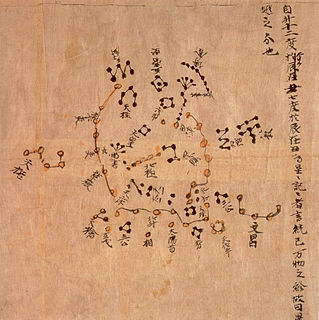 W
WThe Diamond Sūtra is a Mahāyāna (Buddhist) sūtra from the Prajñāpāramitā sutras or 'Perfection of Wisdom' genre. Translated into a variety of languages over a broad geographic range, the Diamond Sūtra is one of the most influential Mahayana sutras in East Asia, and it is particularly prominent within the Chan tradition, along with the Heart Sutra.
 W
WThe Dunhuang Go Manual or Dunhuang Go Classic or simply the Classic of Go is the earliest surviving manual on the strategic board game of Go. Dating from the 6th century, it exists as a single manuscript that was discovered in the 'Library Cave' of the Mogao Caves in Dunhuang, China by Aurel Stein in 1907, and which is now in the collection of the British Library in London, England.
 W
WThe Dunhuang manuscripts are a cache of important religious and secular documents discovered in the Mogao Caves of Dunhuang, China, in the early 20th century. Dating from late 4th to early 11th centuries, the manuscripts include works ranging from history and mathematics to folk songs and dance. There are also many religious documents, most of which are Buddhist, but other religions including Daoism, Nestorian Christianity and Manichaeism are also represented. The majority of the manuscripts are in Chinese. Other languages represented are Khotanese, Kuchean, Sanskrit, Sogdian, Tangut, Tibetan, Old Uyghur language, Prakrit and Old Turkic. The manuscripts are a major resource for academic studies in a wide variety of fields including history, religious studies, linguistics, and manuscript studies.
 W
WThe Dunhuang map or Dunhuang Star map is one of the first known graphical representations of stars from ancient Chinese astronomy, dated to the Tang Dynasty (618–907). Before this map, much of the star information mentioned in historical Chinese texts had been questioned. The map provides a graphical verification of the star observations, and are part of a series of pictures on one of the Dunhuang manuscripts. The astronomy behind the map is explained in an educational resource posted on the website of the International Dunhuang Project, where much of the research on the map has been done. The Dunhuang Star map is to date the world's oldest complete preserved star atlas.
 W
WThe Rare Book Preservation Society (文献保存同志会) was founded in 1940 by Zheng Zhenduo (郑振铎), Zhang Shouyong (张寿镛), He Bingsong (何炳松), Zhang Yuanji (张元济), and Zhang Fengju (张凤举) for the purpose of secretly acquiring and preserving rare books and manuscripts in the Shanghai Jiangnan region. These cultural assets have been accumulated by a number of famous private libraries some over 1,000 years.
 W
WShuanggudui is an archeological site located near Fuyang in China's Anhui province. Shuanggudui grave no. 1, which belongs to Xiahou Zao (夏侯灶), the second marquis of Ruyin (汝陰侯), was sealed in 165 BCE in the early Han dynasty. Excavated in 1977, it was found to contain a large number of texts written on bamboo strips, including fragments of the Classic of Poetry and the Songs of the South, a text on breathing exercises, a "year table" (年表) recounting historical events, a manual on dogs, a version of the I Ching (Yijing) that differs from the received one, and artifacts including the oldest known cosmic board, a divinatory instrument. Like Mawangdui and Guodian, two other tombs from the area of the old state of Chu, the Shuanggudui find has shed great light on the culture and practices of the early Han dynasty.
 W
WThe Sinckan Manuscripts refers to a series of leases, mortgages, and other commerce contracts written in Sinckan, Taivoan, and Makatao; they are commonly referred to as the "fanzi contracts". Some are written only in a romanized script, while others were bilingual with adjacent Han writing. Currently there are approximately 140 extant documents written in Sinckan; they are important in the study of Siraya and Taivoan culture, and Taiwanese history in general although there are only a few scholars who can understand them.
 W
WSutra of the Great Virtue of Wisdom is a 5th-century Chinese manuscript on silk brought from the Mogao Caves in Dunhuang, China. It was brought to Europe by the Paul Pelliot (1878–1945), and it is now housed at the National Library of France in Paris.
 W
WThe Wujing Zongyao, sometimes rendered in English as the Complete Essentials for the Military Classics, is a Chinese military compendium written from around 1040 to 1044.